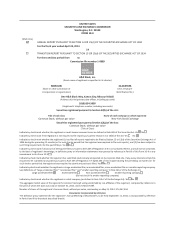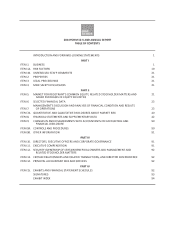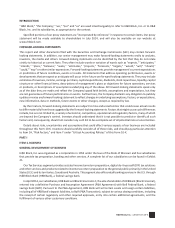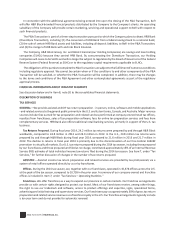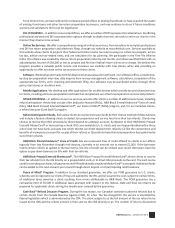HR Block 2014 Annual Report Download - page 16
Download and view the complete annual report
Please find page 16 of the 2014 HR Block annual report below. You can navigate through the pages in the report by either clicking on the pages listed below, or by using the keyword search tool below to find specific information within the annual report.
82014 Form 10-K | H&R Block, Inc.
Limitations on Dividends and Other Capital Distributions. OCC and Federal Reserve regulations impose various
restrictions on federal savings banks with respect to their ability to make distributions of capital, which include
dividends, stock redemptions or repurchases and other transactions charged to the capital account. Additionally, any
distributions of capital or investments by our Holding Companies must be approved by the Federal Reserve.
Under OCC regulations, federal savings banks, such as HRB Bank, may generally make capital distributions during
any calendar year equal to net income of the bank for the previous two calendar years, net of prior dividends paid by
the bank, and current year-to-date net income. OCC regulations generally require that federal savings banks remain
adequately capitalized before and after the proposed distribution. A federal savings bank proposing to make any
capital distribution greater than these limits must obtain OCC approval prior to making such distributions. Because
of the seasonal nature of our business and wide fluctuations in the level of HRB Bank's assets, our Holding Companies
regularly make capital contributions to HRB Bank, and HRB Bank regularly seeks regulatory approval to repay such
capital contributions as extraordinary dividends.
Consumer Protection Laws. In connection with its lending activities, HRB Bank is subject to federal laws designed
to protect borrowers and promote lending, including the Equal Credit Opportunity Act, the Truth-in-Lending Act, the
Home Mortgage Disclosure Act, the Real Estate Settlement Procedures Act, and the Community Reinvestment Act
(CR Act). In addition, federal banking regulations limit the ability of banks and other financial institutions to disclose
nonpublic personal information to unaffiliated third parties. The CR Act requires the OCC to assess HRB Bank's record
in meeting the credit needs of the communities served by HRB Bank, including low and moderate income
neighborhoods. Under the CR Act, institutions are assigned a rating of outstanding, satisfactory, needs to improve, or
substantial non-compliance. HRB Bank received a "satisfactory" rating in its most recent CR Act evaluation.
Bank Secrecy Act/Anti-Money Laundering Laws. HRB Bank is subject to the Bank Secrecy Act and other anti-money
laundering laws and regulations, including the USA PATRIOT Act of 2001. These laws and regulations require HRB Bank
to implement policies, procedures, and controls to detect, prevent, and report money laundering and terrorist
financing, and to verify the identity of its customers. Violations of these requirements can result in substantial civil
and criminal sanctions.
Qualified Thrift Lender Test. As a federal savings bank, HRB Bank is required to meet the Qualified Thrift Lender
(QTL) test. This test requires HRB Bank to have at least 65% of its portfolio assets in qualified thrift investments on a
monthly average for nine out of every 12 months on a rolling basis. As an alternative, HRB Bank may maintain 60% of
its assets in those assets specified in Section 7701(a)(19) of the Internal Revenue Code. Under either test, HRB Bank
is required to maintain a significant portion of its assets in residential housing related loans and investments. Any
institution that fails to meet the QTL test is immediately subject to certain restrictions on its operations, unless it
requalifies as a QTL. These restrictions also include limitations on paying dividends. Failure to meet the QTL test is a
statutory violation subject to enforcement action. As of April 30, 2014, 2013 and 2012, HRB Bank met the QTL test.
Insurance of Accounts. HRB Bank is subject to certain regulations issued by the Federal Deposit Insurance
Corporation (FDIC), which insures the deposits of HRB Bank to the maximum extent permitted by law. This regulation
of HRB Bank is intended for the protection of its depositors.
The FDIC insures HRB Bank's deposit accounts. The FDIC assesses deposit insurance premiums on each FDIC-insured
institution based on its capital, supervisory ratings, and other factors.
Transactions with Affiliates. Transactions between HRB Bank and its affiliates are required to be on terms at least
as favorable to HRB Bank as transactions with non-affiliates, and certain covered transactions are restricted to a
percentage of HRB Bank's capital.
Federal Home Loan Bank System. HRB Bank is a member of the Federal Home Loan Bank of Des Moines (FHLB),
which serves as a reserve or central bank for its members and makes loans or advances to its members. As of April 30,
2014 and 2013, HRB Bank had no outstanding advances from the FHLB.
Consumer Financial Protection Bureau. The Dodd-Frank Act created the CFPB to administer and, in some cases,
enforce U.S. federal consumer protection laws and expanded the role of state regulators with respect to consumer
protection laws. The CFPB may issue regulations that apply to HRB Bank, and to our non-bank subsidiaries that provide
consumer financial services and products. The CFPB may examine, and take enforcement actions against, our non-
bank subsidiaries. See Item 1A for further information on the CFPB.



